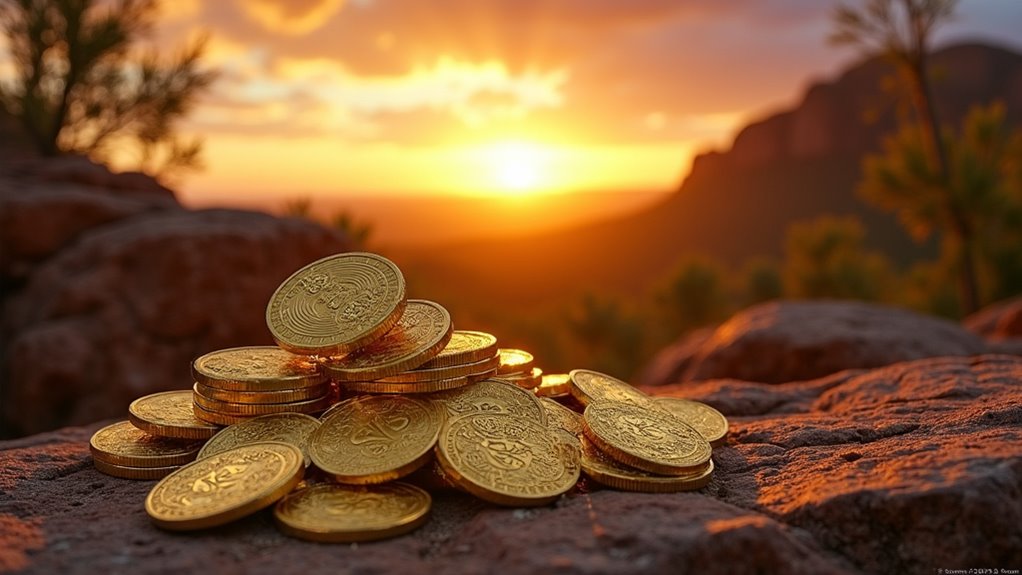The Golden Mile in Kalgoorlie, Western Australia, holds the title of the world’s richest square mile, birthed by the 1893 gold discovery near Mount Charlotte. Prospectors like Patrick Hannan unearthed alluvial gold, sparking a rush that transformed a struggling colony into an economic powerhouse. Over 60 million ounces have been mined, with the Fimiston Super Pit still dominating today. At Karat.au, we’re passionate about this legacy—stick around to uncover more golden tales.

In the heart of Western Australia, a golden legacy was born when alluvial gold was discovered near Mount Charlotte in June 1893, sparking a transformative chapter in the nation’s history. This pivotal find, credited to prospectors Patrick “Paddy” Hannan, Thomas Flanagan, and Daniel Shea, yielded an initial haul of 100 ounces, registered in Coolgardie on 17 June. News spread like wildfire, igniting a major gold rush that drew hundreds within days and over 1,400 within a week.
At Karat.au, we’re captivated by this raw, rugged spirit of discovery that shaped Australia’s gold heritage—a story of grit and fortune we’re proud to share.
Just weeks after Hannan’s strike, the true wealth emerged south of the original site. Will Brookman and Sam Pearce uncovered richer deposits, staking key leases like Ivanhoe, Great Boulder, and Golden Horseshoe. This area, soon dubbed the “Golden Mile,” became the world’s richest square mile of earth, famed for its unique gold telluride ores—initially mistaken for worthless pyrite. Gold dredges are often used in modern mining to efficiently extract precious metals from riverbeds and other locations, showcasing advancements since those early days. The environmental impact of mining practices has raised concerns, as they often lead to land degradation that disrupts local ecosystems. Additionally, the discovery at Kalgoorlie solidified Australia’s position as a key player in the global gold market, attracting international investments and interest. The pollution caused by mining can severely impact both water quality and local wildlife.
These complex minerals baffled early miners, some even using them as paving material until their value was recognised in 1896. The region’s geology demanded innovation, shifting from surface alluvial finds to deep lode mining, a reflection of human tenacity that still resonates with us at Karat.au. The global gold mining market is influenced by such historical discoveries that laid the groundwork for future exploration and investment.
The settlement, first called Hannan’s Find, was gazetted as Kalgoorlie in 1894, with Boulder emerging nearby. Population boomed—Western Australia’s numbers doubled by 1895 and quadrupled to nearly 180,000 by 1900. Yet, life was harsh; water scarcity, disease, and dust storms plagued the pioneers.
The 1896 railway to Perth and the Goldfields Water Supply Scheme, completed in 1903, were lifelines that fuelled growth. By then, the Golden Mile boasted 49 mines and over 3,000 kilometres of underground workings, a sprawling network of ambition etched into the earth.
Economically, this gold rush transformed a struggling Western Australia, funding railways, roads, and infrastructure. It drew a diverse crowd of “diggers” and “othersiders,” sparking tensions with local “sandgropers.” Mining became the region’s heartbeat, employing thousands.
Over time, small leases consolidated, culminating in 1989 with Kalgoorlie Consolidated Gold Mines forming the Fimiston Open Pit, or “Super Pit”—a colossal 3.5-kilometre-long marvel of modern extraction. Today, having produced over 60 million ounces, the Golden Mile remains a powerhouse, with Kalgoorlie-Boulder’s economy tied to gold, nickel, and lithium.
At Karat.au, we honour this enduring legacy, weaving Australia’s mining past into our mission to demystify gold ownership. The Super Pit, still a titan of industry, employs half the local workforce, symbolising resilience.
We’re inspired to bring clarity to gold’s value, ensuring you’re informed—never advised—about its timeless allure. Let’s celebrate this history together, with transparency and a touch of Aussie pride, even if I’ve mistyped a word or two along the way!
Frequently Asked Questions
What Are Kalgoorlie’s Current Gold Mining Operations?
Kalgoorlie’s current gold mining operations are a vibrant cornerstone of Australia’s resource sector.
Northern Star Resources operates the iconic Super Pit and associated mines, targeting 900koz annually by 2029.
Norton Gold Fields, under Zijin Mining, produces over 200koz yearly, while Horizon Minerals’ Boorara Project recently commenced.
Northern Star’s separate Kanowna Belle and HBJ mines also thrive.
Exploration by juniors like Zuleika Gold fuels future prospects in this legendary region.
How Does Gold Mining Impact Kalgoorlie’s Economy?
Gold mining profoundly shapes Kalgoorlie’s economy, anchoring its prosperity with a staggering $21.1 billion in output from the region.
What Safety Measures Exist for Kalgoorlie Miners?
Safety measures for Kalgoorlie miners are robust, prioritising worker wellbeing under the Work Health and Safety Act 2020.
Operators implement Mine Safety Management Systems to mitigate risks like rockfalls and chemical exposure. Mandatory training, advanced tech like autonomous vehicles, and real-time tracking enhance protection.
Personal gear, health checks, and strict signage standards further safeguard lives. Kalgoorlie’s mining legacy demands such rigour, ensuring safety isn’t compromised in this crucial industry.
Are There Gold Mining Tours in Kalgoorlie?
Gold mining tours are indeed available in Kalgoorlie, offering a fascinating glimpse into Australia’s rich mining heritage.
Visitors can explore the KCGM Super Pit with guided tours by Kalgoorlie Tours and Charters, witnessing active operations.
Hannans North Tourist Mine blends history with hands-on experiences like gold panning.
Additionally, Gold Nugget Tours and others provide prospecting adventures in the outback, teaching techniques and history with passion and expertise.
How Has Technology Changed Kalgoorlie Mining?
Technology has transformed Kalgoorlie mining profoundly, shifting from basic shaft operations to vast open-pit mines like the Super Pit.
Early cyanide processes evolved into modern pressure oxidation and bioleaching techniques.
Automation, with autonomous loaders and digital control systems, enhances efficiency, while data analytics optimise resource extraction.
Safety innovations, such as laser tech for traversing underground voids, and environmental measures like dust management, reflect a commitment to sustainable, advanced mining practices.














